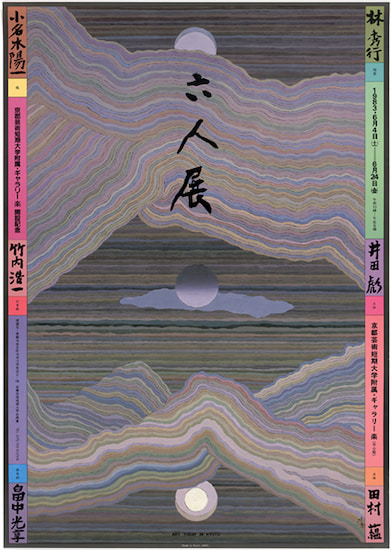Artist Birthday: Awazu Kiyoshi
In Art Today in Kyoto, Awazu's composition focuses on recalling the past artistic glories of Kyoto, the former imperial capital (794–1868 CE) and an important artistic center which fostered some of Japan's most cherished artistic traditions. With a masterful arrangement of positive and negative space and line, Awazu's design mimics the kasumi clouds of mist that appeared in Japanese painting from he Heian period (794–1185) right through the 1800s.
Artist birthday for February 19th: Awazu Kiyoshi (1929–2009, Japan)
Kiyoshi Awazu is part of the flourishing, unique graphic design world of Japan that has really been on a roll since the first decades of the 1900s.
 |
| Awazu Kiyoshi, Art Today in Kyoto, exhibition poster, 1983. Offset lithograph on paper, 28 ½" x 20 ¼" (72.5 x 51.4 cm). Image: The Museum of Modern Art, New York. © 2025 Artist or Estate of Artist. (MOMA-P0065) |
Kasumi, which means mist spreading horizontally in bands, filled the backgrounds of traditional Japanese painting and printmaking as not only indicators of tranquility, but also for the purpose of indicating the spanning of a great depth in a landscape composition. Such clouds were also referred to as "Genji clouds" because they originally became prominent in paintings of scenes of the ancient Japanese novel Tale of Genji starting during the Heian period. The lower forms also mimic the silhouette of Mount Fuji, a prominent subject in Japanese art.
Japanese graphic design was executed almost exclusively in woodblock printing before the introduction of the first lithographic press in 1860. Japan's first lithographic printing company was established in 1872. By 1873 the use of lithography was already popular in Japan. Similar to woodblock printing, a separate stone was required for each color in chromolithography.
The establishment of the first lithographic company was followed quickly by developing the country's first sustainable moveable type technology for printing. By the 1880s, more publishers were using lithography than woodblock printing. By 1900, companies had been established that provided lithographic, typographic and layout services. Offset printing is a technique in which the images on metal plate or litho stone are transferred (offset) to rubber blankets (rollers) and then to the support (paper). This process, perfected in the US in 1903, began being used in Japan after World War II (1939–1945). The main advantage of the medium is the high and consistent quality of the inked image. The process developed in 1903 is still used today by publishing and printing companies.
Between 1900 and World War II (1939–1945), Japanese posters, like many other genre in the arts, absorbed modernist influences from Western art, while integrating it into traditional Japanese subject matter and iconography. Even before WW II, Japanese graphic design had combined the innate Japanese aesthetic of simplicity and understatement with the Western abstraction of form to create an essentially modern style of graphic design. In the 2000s, Japanese graphic design continues to keep pace with a unique contemporary aesthetic that combines the major artistic achievements of Japanese culture with a progressive modernist outlook.
Kiyoshi Awazu was born in Tokyo, and taught himself painting and graphic design. He is credited with being one of the leading Japanese graphic designers after World War II. He began his career in 1954 as a part-time designer in the advertising department of a film company. His posters for Kabuki theater immediately forged a new path for Japanese modern graphic design, in which past important cultural achievements took equal footing in his designs to a modernist visual language. His style rejected the complete sublimation of Japanese graphic design to the international dogma of emphasizing shallow, universal symbols. His idea was to merge Japanese mingei (rural folk art), Zen Buddhist principles, the Japanese woodblock tradition, and calligraphy with modern culture.
This image is in the following Davis program: Davis Collections: Graphic Design

Comments